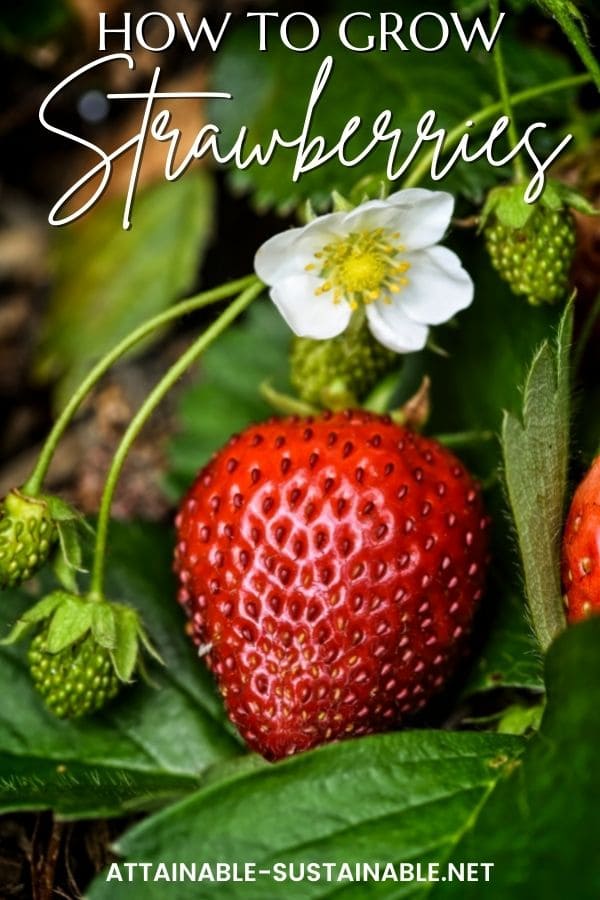Growing strawberries in the home garden can be a tremendously fruitful endeavor. Strawberry plants are perennial, which means they’ll thrive in your garden for several years, making sweet berries every season to spoon over shortcake or make into strawberry ice cream.
If you’re harvesting strawberries from your garden, be sure to try making a batch of strawberry mead!
Contributed by Jodi Torpey, author and Master Gardener.
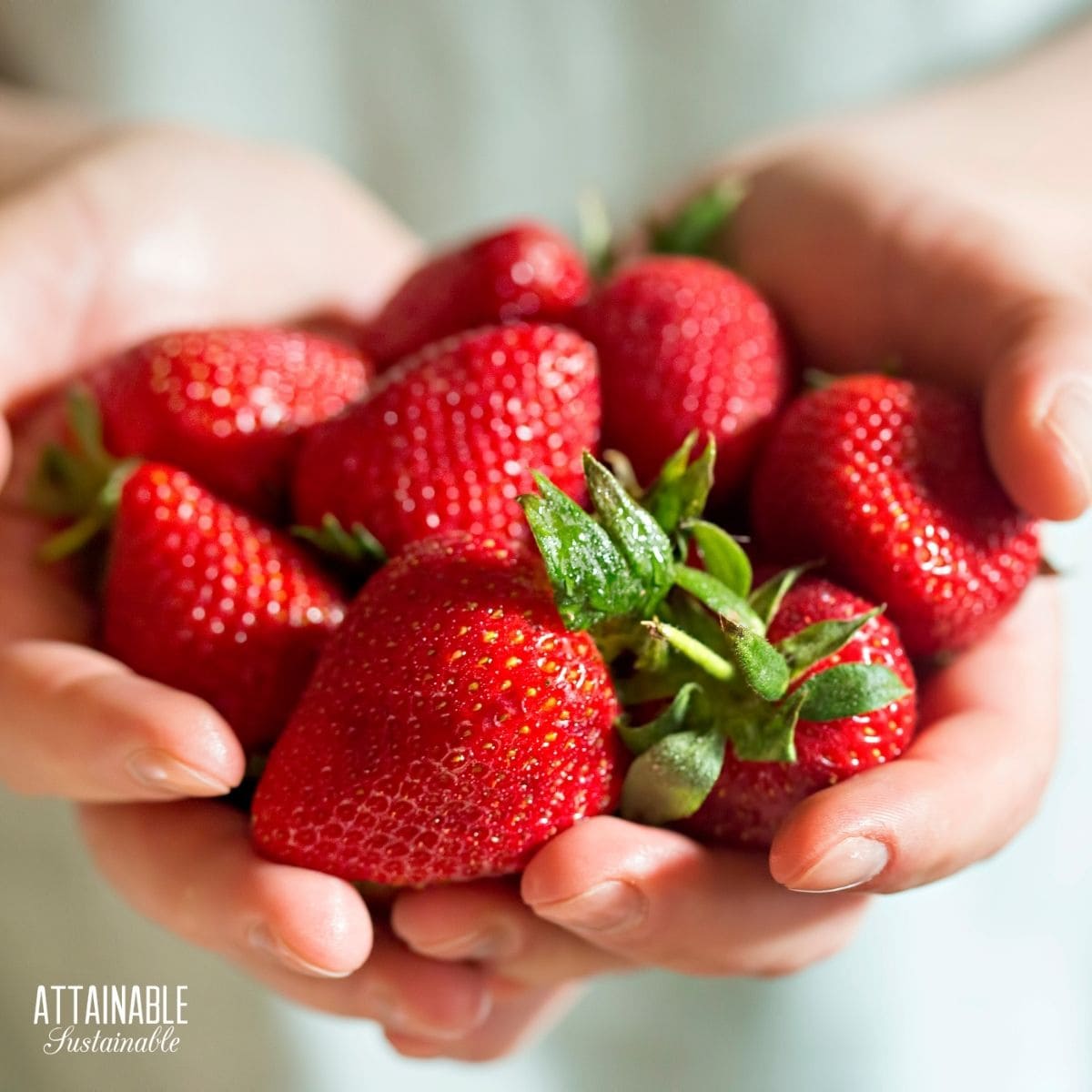
Growing strawberries
Strawberries have been a garden favorite for centuries, starting in well-tended European gardens. These plants are hardy perennials and some of the easiest small fruits to grow in a home garden.
Strawberry plants have lovely green serrated foliage; delicate white, pink or red flowers; and beautiful, luscious berries. Gardeners can plant special strawberry patches, use plants along the borders of raised beds, or even plant strawberry containers on the patio.
New developments in strawberry breeding mean just about anyone can plant, grow and enjoy fresh strawberries from late spring through summer and into fall.
Grow Some Greens!
Ready to grow fresh greens, no matter WHERE you live? Sign up for my
FREE quick-start guide and start growing some of your own food!
Select your strawberry planting site carefully because that directly affects the production of the strawberry crop. Some gardeners start planning and preparing their strawberry patch the season before they plant it. Plan where you’ll place your plants, such as the front of gardens where taller plants won’t grow and block their light.
An added benefit to planting strawberries is that when plants spread they can act as a natural weed barrier.
Make sure the area gets full sun (8 hours) a day, is well-drained (especially in winter), and has some protection from the wind. Keep in mind the previous crops that were grown in that same area. To prevent soil fungal problems, avoid planting strawberries where these crops were planted in the previous 3-5 years: raspberries, cherries, tomatoes, potatoes, eggplant, and peppers.
New to gardening? Limited on space? The 5-Gallon Garden gives you the skills you need to grow food in the space you have. Get started with your garden today!
Strawberry types to choose from
The three main strawberry (Fragaria x ananassa) types to choose for your garden include June-bearing, everbearing, and day neutral.
Some garden catalogs group everbearing and day-neutral together because the growing season for both ranges from spring to fall. To make the most of the strawberry season, plant some of each kind in your garden.
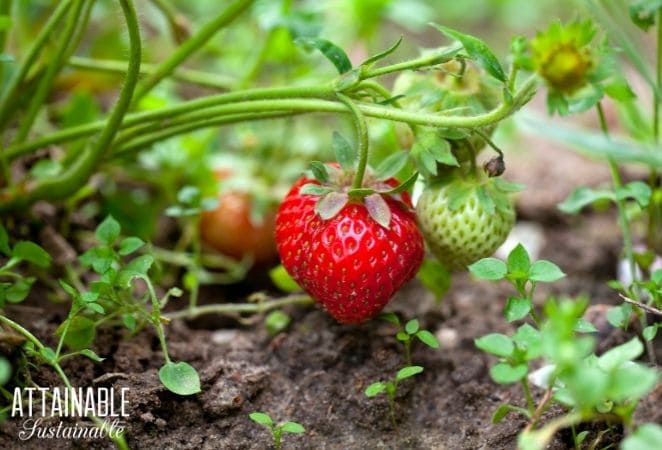
Thriving strawberry plant
June-bearing strawberries are flavorful and fragrant. These strawberry plants produce fruit over several weeks in spring and do best planted in matted rows. These berries are best for jams and jellies!
Two June-bearing strawberry varieties include Earliglow and AC Wendy. Earliglow is one of the easiest strawberries to grow and they start in spring. Beautiful glossy fruits grow on plants that can spread to 24-36”. Grows well in containers. (Zones 4-8).
AC Wendy is a high-yielding strawberry that’s bred to resist foliar diseases such as verticillium wilt and can grow in heavier soils and containers; spreads 24-36” (Zones 4-8).
Everbearing strawberries produce a spring and fall crop each season and grow well in sandy soil. They do best when planted in hills.
Two everbearing strawberry varieties include Eversweet and Ruby Ann. Eversweet is bred to grow well in hot, humid weather; produces large sweet strawberries from spring into fall. Plants spread 12-16” including containers (Zones 5-8).
Ruby Ann produces dark red flowers that grow into an abundant harvest of sweet strawberries on trailing runners; spreads 10-24”; container friendly (Zones 3-8).
Day-neutral strawberries produce fresh fruit through summer into fall, and yield is fewer strawberries overall. These also do best when planted in hills.
Two day-neutral strawberry varieties include Albion and Seascape. Albion produces large cone-shaped berries that are especially sweet; plants will produce larger strawberries if they aren’t crowded. Good disease resistance and heat tolerance for hot summers; plants spread 12-24” (Zones 4-7).
Seascape produces brilliant red strawberries that can grow in a variety of garden soils. Plants offer large harvests of berries in spring, summer, and fall; spreads to 24-36” (Zones 4-8).
How to plant strawberries
After the danger of frost has passed, and as soon as the soil is workable in spring, amend the soil in your strawberry bed with deeply dug organic matter like compost and well-aged manure. Plan ahead for watering with a drip irrigation system or soaker hose set up.
Strawberries are often available as a bare root crop, meaning the roots are free of soil. They are only available this way in the late winter, as the plants are dormant at that time.
Transplant strawberry plants into the garden. The two most common ways to plant strawberries are in matted rows or on small hills.
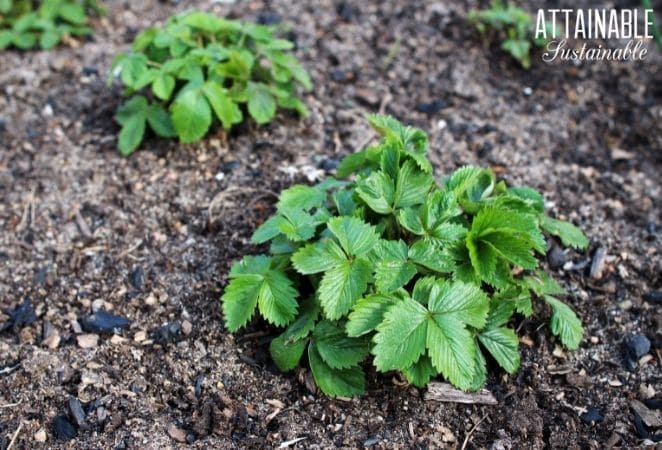
Strawberry plants in matted rows
To make matted rows, space strawberry plants 12-24 inches apart in each row and 43 inches between rows. A solid mat of plants will fill in the space, so be sure to plan for a walkway between rows.
For hills, prepare small raised mounds to help with drainage. Space hills about 9-12 inches apart. Runners are typically removed so the garden is made up of separate plants.
No matter how you plant, be sure to plant so the roots are spread out and the crown is just above soil level to prevent the plant from either rotting or drying out.
Mulching with straw or other organic mulch will help keep roots from drying. Be sure to protect strawberries through the winter with added mulch (at least 1-2 inches thick),
Requirements for growing strawberries
Soil requirements
In general, strawberries require well-amended soil to keep plants healthy. However, some strawberry varieties can grow well in sandy loam soil and others can grow in heavier soil. It’s important that the soil is well-draining to keep water from drowning plant roots.
Light requirements
Strawberry plants need full sun, at least 8 hours of sun a day. In places that have high-intensity sun, plan on protecting plants with row cover cloth or other types of shading.
Fertilizer and water requirements
Plants will probably need a mid-summer (like early July) feeding. Fertilize the strawberry plants with a high-nitrogen fertilizer and water. Another application of fertilizer in September is helpful to give plants a boost.
Strawberry plants need consistent moisture and drip irrigation works well. Make sure to get water to plant roots in the mornings, at the soil level. Avoid foliar problems by keeping leaves dry.
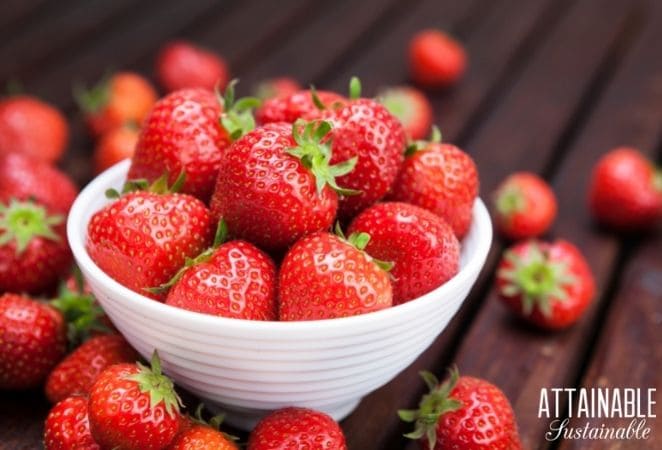
Delicious ripe garden strawberries
Strawberry pests and other problems
Strawberries are susceptible to a number of problems that range from root rot to slugs. One way to keep plants healthy is to water carefully to make sure the soil is consistently moist but not soggy.
You can prevent some plant issues by planning ahead before planting. For example, select strawberry varieties that are known to resist leaf diseases or that thrive in hot and humid weather. To reduce problems with insect pests, avoid planting strawberries near cabbage family crops, other berry crops, and fields of alfalfa.
Watch for plant problems and take action quickly:
Slugs—Slugs cause damage to fruit and leaves that are in contact with the ground. Water in the morning to allow the soil to dry during the day. Keep plants thinned to allow for good air circulation. Set out slug traps and baits in the evening and dispose of slugs in the morning.
Birds—Keep birds from getting to your strawberries by covering them with netting or chicken wire. If using netting, make sure birds can’t become trapped in it by using a ¼-inch mesh.
Rabbits—Grow strawberries in containers or raised beds high enough that rabbits can’t reach.
How to grow strawberries in containers
Strawberry plants are great contenders for container gardening and raised beds. Using these types of controlled growing environments can help reduce weeds as well as pests.
Strawberries grow well in containers if you select a container-friendly variety and plant in a large enough container. Select plants that are hardy to your zone for the best chance of success.
Fill containers with good-quality potting soil made for container planting. Potting soils typically have fertilizer included, but you may need to mix in some compost to ensure the soil will drain well.
Transplant strawberry plants into prepared containers and follow the spacing recommendations for the variety. Keep plants watered and fed while plants are growing. Harvest berries as needed.
Be sure to protect plants during cold winters by moving containers to a sheltered spot and adding a thick layer of mulch.
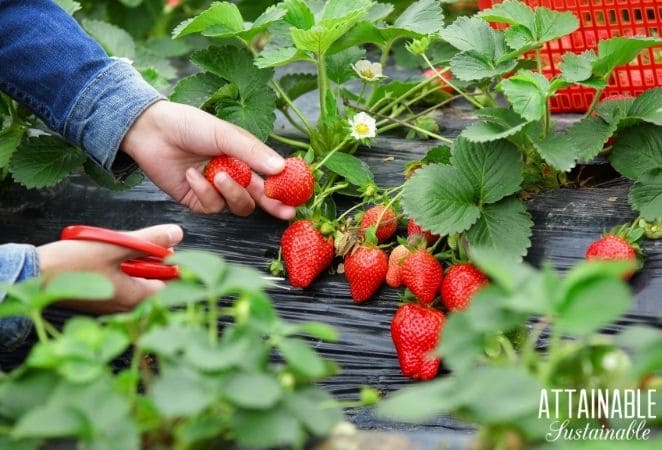
Harvesting ripe strawberries
When to harvest strawberries
It’s best to pinch off flowers the first year so plants will set down roots, instead of fruit. Waiting until the second season to enjoy the fruits is difficult, but the result is healthier plants and a larger crop of strawberries.
For the best flavor, let strawberries mature on the plant until they’re red-ripe. Picking them too early results in smaller fruits that may not be as sweet. Depending on the variety, strawberries may be ready to pick about 30 days from when they flower.
Snip berries from the plant, leaving the stem and cap intact. Enjoy right away or store in the refrigerator.
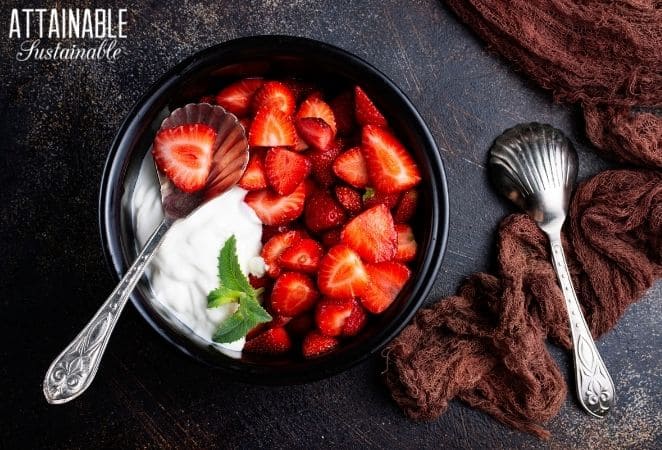
Strawberries and whipped cream dessert
How to use strawberries in the kitchen
Many strawberries don’t make it as far as the kitchen because gardeners are known to pick and eat them while standing in the garden.
If strawberries do make it inside, they make delicious toppings for breakfast cereals, drizzled with balsamic vinegar for summer salads, dried for a snack to-go, topped with whipped cream for dessert, made into jams and jellies, muddled into tasty drinks, turned into strawberry salsa, and so much more. Any leftover strawberries can be frozen to enjoy a taste of summer anytime.
How to propagate strawberries
Strawberry plants are easy to propagate by planting the runners that grow on plants. Select healthy runners that have a few leaves (and some may have small roots). Leave the runner attached to the main plant and place the runner in a small pot filled with soil. Hold the runner in place with small pieces of u-shaped wire or devise a type of pin to keep the root or bottom of the leaves in contact with the soil.
Keep the soil moist and wait for new roots plus a few new leaves before cutting the strawberry runner from the mother plant. Plants will grow in their pots until you’re ready to transplant them into the strawberry patch.
Looking for more ways to use your fresh strawberries? Try this quick strawberry compote and this easy strawberry cobbler!


